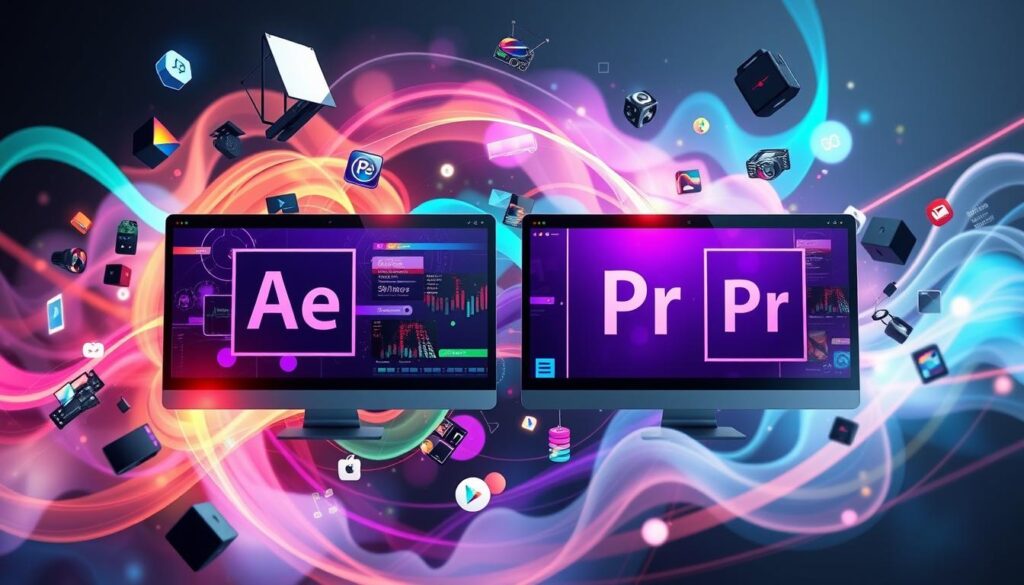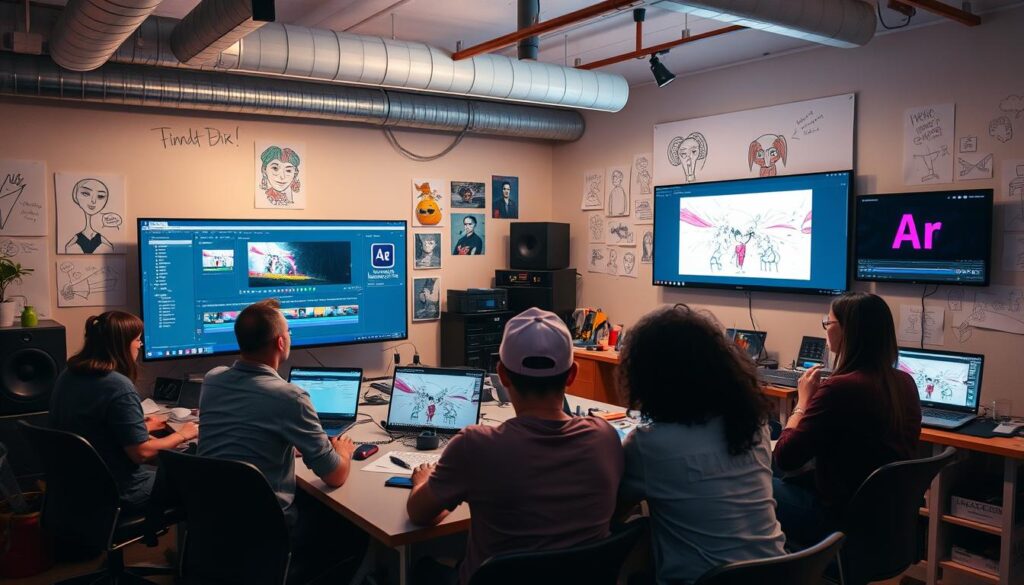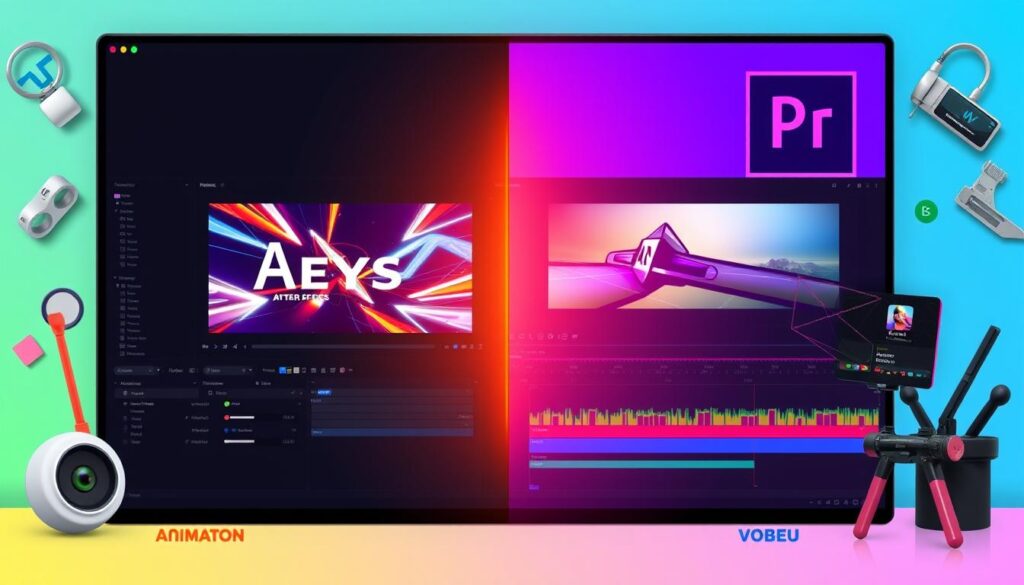In the world of video production, Adobe’s After Effects and Premiere Pro are top choices. They have many features, but which one is better? This detailed comparison will look at their strengths and weaknesses. It will help you decide which one suits your video editing and post-production needs.
Key Takeaways
- After Effects and Premiere Pro are both powerful video editing and motion graphics software developed by Adobe.
- Premiere Pro excels in non-linear editing, color correction, and audio editing, making it a versatile all-in-one video editing solution.
- After Effects specializes in creating complex motion graphics, visual effects, and compositing, offering advanced tools for animating and manipulating media.
- The choice between After Effects and Premiere Pro often depends on the specific requirements of a project, with many professionals using a combination of both programs for a seamless post-production workflow.
- Factors such as performance, system requirements, pricing, and industry trends should also be considered when deciding which software to use.
What Are After Effects and Premiere?
Adobe’s Creative Cloud suite is a powerful collection of multimedia applications. Two key tools are After Effects and Premiere Pro. They are crucial for video production but serve different roles.
Adobe’s Video Editing Suite
After Effects focuses on motion graphics, visual effects, and advanced video compositing. It’s a versatile tool for video professionals. They can use layers, animation, and many effects and plugins to bring their visions to life.
Premiere Pro, on the other hand, is a non-linear video editing software. It’s great for timeline-based editing, color correction, and audio mixing. It has all the tools needed to assemble footage, refine the narrative, and polish the final product.
Key Differences Between the Two Applications
After Effects and Premiere Pro are both vital in the Adobe Creative Cloud ecosystem. They cover different parts of the video production process. Knowing their unique strengths helps video professionals work more efficiently and achieve better results.
| After Effects | Premiere Pro |
|---|---|
| Motion graphics and visual effects | Non-linear video editing |
| Compositing and animation | Color correction and audio editing |
| Advanced video manipulation | Timeline-based editing |
| Layered and effects-driven workflows | Streamlined editing and post-production |
Understanding what After Effects and Premiere Pro can do helps video professionals. They can use each tool’s strengths to make stunning productions.
Post-Production Workflow: When to Use Each Program
Understanding when to use video editing workflow, After Effects, and Premiere Pro is key. This knowledge helps make your post-production process smooth and efficient. Let’s look at which tasks each program is best for.
Premiere Pro is great for simple video editing. You can trim clips, adjust sound levels, and add basic transitions here. Its easy-to-use interface and wide range of tools make it ideal for most editing jobs.
After Effects is perfect for advanced tasks. It’s the top choice for creating complex motion graphics, visual effects, and composites. It’s also excellent for tasks like keying, rotoscoping, 3D animation, and mixing different media into one final product.
- Use Premiere Pro for:
- Non-linear video editing
- Color correction and audio editing
- Straightforward video production tasks
- Utilize After Effects for:
- Motion graphics and visual effects creation
- Advanced compositing and integration of various media
- Specialized animation and 3D elements
Knowing the strengths of each program helps you create a smooth post-production workflow. This approach ensures your videos look amazing.
“Mastering the nuances of After Effects and Premiere Pro can elevate your video production to new heights and provide you with the tools to bring your creative vision to life.”
Premiere Pro: The All-in-One Video Editing Solution
Premiere Pro is Adobe’s top video editing software. It’s loved by pros in the video world. It’s great for editing, color correction, and audio work, making it perfect for many video projects.
Non-Linear Editing and Timeline Management
Premiere Pro shines with its easy non-linear editing. You can move video, audio, and graphics around on a detailed timeline. This makes editing smooth and flexible.
The software’s timeline tools give you exact control. This ensures your video looks polished and flows well.
Color Correction and Audio Editing Tools
Premiere Pro also has top-notch color correction and audio tools. You can tweak your video’s look with its color grading. And, its audio tools let you fine-tune sound, from voices to music.
| Feature | Premiere Pro | After Effects |
|---|---|---|
| Non-linear Editing | ✓ | – |
| Color Correction | ✓ | – |
| Audio Editing | ✓ | – |
Premiere Pro is a top choice for video editing. It meets the needs of creators in many fields. It’s great for broadcast, film, and online videos.
Is After effect better than premiere?
Motion Graphics and Visual Effects Capabilities
Adobe After Effects is the top choice for motion graphics and visual effects. It has a powerful toolset for keyframing, compositing, and visual effects. This makes it the best software for complex animation and VFX projects.
After Effects is great at:
- Seamless integration of 2D and 3D elements
- Sophisticated particle simulations and motion graphics
- Advanced color correction and color grading
- Chroma keying and green screen compositing
- Implementing cinematic visual effects like lens flares, glows, and transitions
The software’s keyframing capabilities offer precise control over animation. This makes it perfect for creating dynamic and captivating content. It’s ideal for motion graphics, visual effects, or 3D compositing.
While Premiere Pro is great for video editing, After Effects is the clear winner for motion graphics and visual effects. Its specialized tools and integration with Adobe Creative Cloud make it essential for professionals in video production and motion design.
Integrating After Effects and Premiere for Seamless Editing
After Effects and Premiere Pro are key tools in video making. They work together smoothly through Dynamic Link and project sharing. This makes editing faster and more efficient.
Dynamic Link and Project Sharing
The Dynamic Link feature lets users switch between After Effects and Premiere Pro easily. No need for slow file transfers. Changes are seen right away in both apps. Plus, team members can work together on the same project.
This makes editing smoother and less stressful. Video editors can spend more time on creativity. It’s great for big projects needing lots of editing, graphics, and effects.
User Interface and Learning Curve
Video editing software’s user interface (UI) and learning curve are key. After Effects and Premiere Pro are top choices, each with its own feel. They meet different needs and skill levels.
Premiere Pro is easy to use, great for newbies and pros. Its timeline-based editing is familiar to many. You can also customize your workspace to fit your style.
After Effects is more complex but offers deep features. It’s perfect for those into motion graphics and visual effects. Its node-based compositing system gives precise control over elements.
- Premiere Pro: Intuitive timeline-based editing, user-friendly interface, suitable for beginners and experienced editors
- After Effects: Powerful node-based compositing, complex interface, ideal for motion graphics and visual effects experts
Choosing between After Effects and Premiere Pro depends on your project and experience. Many use both for the best results. This way, they get the most out of each program.
“The user interface is the first thing a new user encounters, and it can make or break the entire experience.”
Performance and System Requirements
Video editing performance is key, and After Effects and Premiere Pro have different needs. Each program requires specific hardware for the best results. Knowing these requirements is essential for a smooth editing process.
Hardware Considerations for Smooth Editing
For top-notch After Effects work, you need a strong processor, lots of RAM, and a dedicated graphics card. The project’s complexity, like layers and effects, affects the needed hardware. Premiere Pro focuses on fast storage, like an SSD, for smooth playback and quick timeline actions.
| System Requirement | After Effects | Premiere Pro |
|---|---|---|
| Processor | High-end CPU with multiple cores | High-end CPU with multiple cores |
| RAM | 16GB or more | 8GB or more |
| Graphics Card | Dedicated graphics card with CUDA or OpenCL support | Dedicated graphics card with GPU acceleration |
| Storage | Fast SSD for project files and media | Fast SSD for project files and media |
Keep in mind, the exact hardware needs depend on your project’s complexity, video resolution, and used effects. Upgrading your system regularly can make your After Effects and Premiere Pro workflow smoother and more efficient.
Pricing and Subscription Models
When choosing between After Effects and Premiere Pro, pricing is key. Both are part of Adobe’s Creative Cloud. They offer flexible plans to fit your budget and needs.
Adobe’s pricing lets you pick what you need. You can choose the individual app plan for one tool. Or go for the Creative Cloud plan for the whole suite.
| Subscription Plan | After Effects | Premiere Pro |
|---|---|---|
| Individual App Plan | $20.99/month | $20.99/month |
| Creative Cloud Plan | $54.99/month | $54.99/month |
The individual app plan is cheaper if you only need one tool. The Creative Cloud plan gives you access to the whole Adobe suite. This includes Photoshop, Illustrator, and InDesign, making it great for professionals and teams.
Choosing between After Effects and Premiere Pro depends on your needs and budget. Knowing the subscription options helps you make a choice that fits your creative and financial goals.
Industry Trends and Professional Workflows
In the fast-paced world of video production, After Effects and Premiere Pro are key tools for pros. They’re used in everything from TV shows to movies. These Adobe apps show how versatile and powerful they are.
Broadcast, Film, and Online Video Production
After Effects is top for motion graphics and visual effects in TV. It helps make content that grabs viewers and boosts production quality.
In film, Premiere Pro is essential for editing. It works well with After Effects to make editing smooth and precise.
Online video is booming, and After Effects and Premiere Pro are in high demand. They help create engaging content for social media and corporate videos.
| Industry Segment | Preferred Program | Key Capabilities |
|---|---|---|
| Broadcast Television | After Effects | Motion graphics, visual effects, title sequences |
| Filmmaking | Premiere Pro | Non-linear editing, seamless integration with After Effects |
| Online Video Production | After Effects, Premiere Pro | Visually engaging content, efficient post-production workflows |
After Effects and Premiere Pro keep leading in video production. They help professionals create amazing content that inspires and captivates.

Third-Party Plugins and Extensions
The world of video editing and motion graphics is always changing. Users of After Effects and Premiere Pro can improve their skills with third-party plugins and extensions. These tools add new features, make your workflow smoother, and help you create amazing visual effects.
Some top After Effects plugins are:
- Trapcode Suite by Red Giant: It has many tools for making dynamic 3D graphics and particle effects.
- Element 3D by Video Copilot: It lets you easily add and animate 3D models in After Effects.
- Particular by Aescripts: It offers a wide range of particle effects and simulation tools.
For Premiere Pro users, some great plugins are:
- Boris FX: It has tools for advanced color grading, visual effects, and motion graphics.
- Sapphire by FXHome: It has a huge library of high-quality effects and transitions.
- Film Convert: It helps you get a cinematic film look by simulating different film stocks and cameras.
These are just a few examples of the many plugins for After Effects and Premiere Pro. Using these tools, you can explore new creative options, make your post-production workflow easier, and enhance your video projects.
Cross-Platform Compatibility and File Formats
Video editing needs smooth cross-platform work and many file formats. After effects and premiere pro make it easy to share and work on projects together. This makes your work flow better, no matter the system you use.
After effects and premiere pro support lots of file formats. You can work with standard video and special graphics files. This lets you easily move your projects between different software and systems.
Compatibility and File Format Support
- Adobe’s after effects and premiere pro work well together. They link smoothly, making it easy to share and work on projects.
- They support many file formats. This includes video, audio, images, and animations. You can work with files like MP4, WAV, and PNG.
- This support means you can share and work on projects easily. It doesn’t matter if your team uses different software or systems.
Using after effects and premiere pro helps you create amazing visual effects. You can add them to your videos easily. This keeps your work flow smooth, no matter the platform or file format.
| File Format | After Effects | Premiere Pro |
|---|---|---|
| MP4 | ✓ | ✓ |
| MOV | ✓ | ✓ |
| AVI | ✓ | ✓ |
| WAV | ✓ | ✓ |
| MP3 | ✓ | ✓ |
| PSD | ✓ | ✓ |
| AI | ✓ | ✓ |
| PNG | ✓ | ✓ |
| FLV | ✓ | ✓ |
| GIF | ✓ | ✓ |
Collaborative Editing and Team Workflows
In today’s fast-paced video world, teamwork and smooth workflows are key. After Effects and Premiere Pro have tools that help teams work well together. They make it easier for video pros to tackle big projects.
Premiere Pro shines with its real-time project sharing and team work. It lets many users edit the same project at once. This makes it great for teams spread out or projects needing input from many people.
After Effects is top-notch at working with Premiere Pro through Dynamic Link. This lets after effects artists create visual effects and motion graphics. Then, they can easily pass their work to the Premiere Pro team. This makes the post-production process smooth and efficient.
| Collaboration Feature | Premiere Pro | After Effects |
|---|---|---|
| Real-time Project Sharing | ✔ | – |
| Dynamic Link Integration | ✔ | ✔ |
| Team-based Workflow | ✔ | ✔ |
| Review and Approval Process | ✔ | – |
Using the teamwork tools in After Effects and Premiere Pro helps teams work better. It improves communication and makes projects of high quality faster.

Resources for Learning After Effects and Premiere
Learning After Effects and Premiere Pro can be very rewarding. It often takes a lot of practice and the right resources. Whether you’re new to video editing or want to get better, there’s a lot to help you.
Online tutorials, training materials, and tools are plentiful. They support your journey from start to finish. You can find everything from beginner guides to advanced techniques.
Online Tutorials and Training Materials
YouTube is full of free tutorials. Channels like Adobe Creative Cloud and Skillshare have lots of videos. They cover After Effects and Premiere Pro in detail.
Udemy, Lynda.com (now LinkedIn Learning), and Coursera also offer great courses. These are taught by experts in the field. They help you learn a lot.
Adobe’s official training is also a great resource. Their website and app have lots of tutorials and webinars. They help you learn the software and keep up with new trends.



